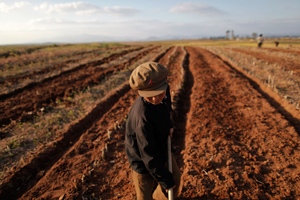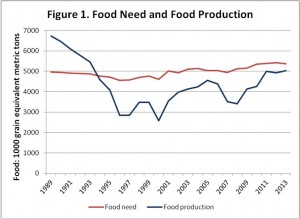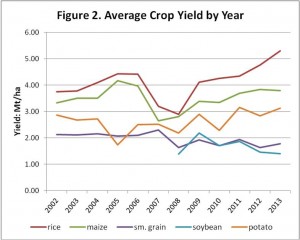The State of North Korean Farming: New Information from the UN Crop Assessment Report
 The United Nations Food and Agriculture Organization and World Food Programme recently released their 2013 Crop and Food Security Assessment Report (CFSAR) for the DPRK, continuing a series of annual reports on farm production begun in 1995.[1] Like its predecessors, the 2013 CFSAR estimates the total main season production of major food grains and tubers, and projects next year’s harvest of winter wheat and barley as well as spring potato crops. Overall, the CFSARs provide a useful time-series of data to analyze changes and developments in the North’s farm sector.
The United Nations Food and Agriculture Organization and World Food Programme recently released their 2013 Crop and Food Security Assessment Report (CFSAR) for the DPRK, continuing a series of annual reports on farm production begun in 1995.[1] Like its predecessors, the 2013 CFSAR estimates the total main season production of major food grains and tubers, and projects next year’s harvest of winter wheat and barley as well as spring potato crops. Overall, the CFSARs provide a useful time-series of data to analyze changes and developments in the North’s farm sector.
Like all reports on North Korea, the CFSARs are by no means perfect, but we have come a long way from the 1990s when for most reports, any precision after the first digit represented a wild guess. While there are certainly errors in the estimates, the reports have benefitted from the use of a consistent methodology over many years and improved cooperation from DPRK authorities. Moreover, since 2011, the assessment teams have included international Korean-speaking members, and since last year, they have been able to take sample crop cuttings from selected fields as a cross check against farm production reports. In 2013, as in recent years, there were four assessment teams, accompanied by members of the resident international aid community. They visited 51 farms from 27 counties in all nine agricultural provinces, and also interviewed a small number of individual households. The mission used official data provided by the government, but adjusted those data based on ground observations and satellite information.
General Findings
The 2013 CFSAR has two main conclusions:
- Aggregate farm production is again up slightly, bringing the North the closest it has come to sufficiency in almost two decades. Production rose to a total 5.03 million metric tons (mMt), cereal equivalent, slightly less than the estimated annual food requirement of 5.37 mMt.[2] Assuming that commercial grain imports (mostly from China and Russia) stay around 300,000 Mt as they have for the last several years, the shortfall is only 40,000 Mt, valued at around $8 million in the world market.[3] That said, the CFSAR methodology assumes an average per capita food requirement of 174 kg grain equivalent per person/ year, amounting to around 1640 kcal/day. The missions have consistently assumed that the remaining energy (>400 kcal) and other nutrients are “derived from the limited quantities of available fish, poultry, meat, sweet potatoes, vegetables, fruits, and wild foods.” Given how limited those other sources are, North Koreans still by no means get enough to eat. (Figure 1 graphs the change in aggregate food production compared to need over time.)
- Despite signs last year that price structure and farm-led incentives might be changed, the 2013 mission found no evidence that there had been any changes in pricing for farms or any incentives other than “traditional” ones where sub-work teams receive benefits if their production exceeds specified targets.[4] In 2012, the mission recommended for the first time that pricing policy for agriculture produce should be changed to provide more of an incentive for production. Prior to that, recommendations had been confined entirely to agronomic and land use issues. Because the DPRK does not appear to have moved forward on this front, the mission again recommended that changes in agricultural marketing are necessary to increase productivity. Given that the CFSARs are produced in cooperation with the DPRK government, and subject to certain diplomatic constraints regarding their conclusions, one can speculate that the relatively mild wording of this recommendation covers an increasing frustration among aid donors that the structural obstacles to farm production in the DPRK are still not being addressed.

Areas of Change
Nonetheless, some things are changing—for better and for worse. For starters, rice yields have steadily increased since 2008 and now are at the almost respectable level of 5.3 Mt/ha (see Figure 2). This is a noteworthy achievement and reflects the emphasis that Korean farmers place on rice production.

Second, the area allocated to winter grains for double cropping has declined, especially since 2010. This trend is also a positive change because the double cropping system creates untoward stresses on the soil, and production has been extremely uneven and low, depending especially on the severity of winter weather. Winter wheat and barley are insurance crops for the hungry months of the spring, but in a more productive farming system should be mostly discontinued.
Third, given declining access to chemical fertilizer but an overall increase in food production, one can speculate that the use of compost and other organic fertilizer has expanded. The DPRK has emphasized this practice since at least the late 1990s, and beginning six or seven years ago, efforts were coordinated to develop composting systems that used crop residue as well as animal wastes much more effectively than previously, with corresponding improvements to crop yields.
Finally, the area planted to soybean, which began to rise from 2008 to 2011, has declined in the last two years. Since soybean is the primary source of protein in the North Korean diet, this development is unfortunate. Yields have apparently also declined, compounding the problem. The assessment mission notes for the second year that the farm price for soybean is much too low compared to the price of maize, thus undercutting any economic motivation for farmers to plant this essential crop.[5] In contrast, the 2011 CFSAR was very optimistic regarding increased soy production, with a rather detailed discussion of the motivation and reasons why the planted area had increased to 131,000 ha from 68,000 ha in 2009. Production in 2011 was 245,000 Mt or about 10 kg/person—not a great deal but still a vital contribution to a diet strikingly short of protein. Unfortunately, the area fell in 2013 to 116,000 ha and yields declined from 1.8 to 1.4 Mt/ha, bringing the per capita production down to 6.5 kg.
Areas of Stagnation
Other aspects of the DPRK agricultural sector appear to be unchanged. Yields of crops other than rice show no apparent trend, with variations due to weather as much as anything else (see Figure 2). In addition to the decline in soybean yields, winter grain yields are also down. Maize and potatoes are trending upward, but with no strong consistency.
Second, crop diversity remains low and highly concentrated on rice and maize, especially with the decline in winter grains and soybean. Leguminous crops (soybean, mung bean, etc.) have been identified for many years as an essential addition to the DPRK crop mix, but to date, have not been planted at an adequate level. Rotating crops helps to break disease and insect cycles, and legume crops, which add nitrogen to the soil, also contribute to better yield in the following season.
Third, the fertilizer supply is still inadequate, and the mix very imbalanced. Application of phosphate and potassium (almost all locally produced) is very low. Plants require a balanced mix of nutrients and without adequate phosphate and potassium, which contribute to root and seed health, the plant does not grow well, even when plenty of nitrogen is available. Soils in the DPRK are also typically very acidic, which chemically binds the main nutrients in ways that reduce their availability to plants. But farms have consistently been unable to apply enough lime to counteract this acidification.
Finally, the official prices farms receive for their grain crops are still set by the state at levels on the order of 2 percent of the market price, thus removing any economic motivation to increase the supply of grains to the state.
Reading between the Lines
Given our general understanding of DPRK farming, the 2013 CFSAR allows us to speculate about certain details of farmer behavior and the farming system.
The continued improvement of rice yields, compared with those of other crops, suggests that farmers are preferentially allocating scarce resources to the desired and more valuable crop of rice. Rice is typically grown in the best fields, and large-scale improvements in the reliability of the national irrigation system (especially the move from a reliance on pumping to gravity supply in most fields) have undoubtedly benefitted this crop.
The question of rice planting technology is not directly addressed by the mission. A method known as SRI—System of Rice Intensification—was introduced about five years ago and has the potential to increase yields by 20 percent or more, other things being equal.[6] It is reportedly popular in the North but SRI is coupled with the use of plastic trays for planting the rice seedlings, and thus implementation is somewhat dependent on the availability of those trays (which are all imported). Some of the increase in rice yield is very likely caused by the wider use of SRI.
Maize is grown on a wide variety of fields, not all of good quality. Lacking adequate resources, farmers rationally focus on the fields and crops with the greatest potential. We know anecdotally that some farms regularly obtain maize yields of around 8 Mt/ha on some fields, which is quite respectable. But the wide areas of marginal soil with poor water supply necessarily pull the national average down, and farmers who have access to a mix of field types are likely to short-change the poorer fields. This combination of poor soil and differential allocation of resources probably contributes to the uneven pattern of maize yield over the years. In a more economically and environmentally rational system, these lower quality fields would be planted with crops other than maize, such as orchards or forage crops for livestock, or at the very least rotated out of grain every other year. However, farm quotas for grain production force farmers to grow maize where other crops would be more suitable.
The CFSAR reports that steeply sloping hillsides are still being planted with grains. This is a continuing response to chronic food shortages, but subjects the land to permanent damage from severe erosion. The Ministry of Land and Environmental Protection regulates this practice to some degree, with land use assigned to “Land User Groups” made up of under-employed factory workers. Based on remote sensing data, the mission estimates that 550,000 ha of land with slope greater than 15 degrees is being farmed, and produces about 220,000 Mt of grain (or equivalent). This is about 4 percent of total food production, but uses (and degrades) land equal to about a quarter of the main farm fields.
Areas of continuing uncertainty in the farming system include production from household gardens and the extent of post harvest losses. The area of household gardens at the farms can be well estimated based on the number of households, but yields are less certain. Based on repeated observations by international aid workers, since 2008, the reports have assumed potatoes and corn are grown on half the area of household and kitchen plots (vegetables on the rest), at an average yield of 6 Mt/ha, for a total addition of 75,000 Mt to the national production. Because of the intensive care given to these small plots, the figure is not unreasonable. While the grain contribution is small, household gardens produce a significant proportion of the fruits and vegetables consumed in the North, and are the foundation of the farmers’ markets.
While post-harvest losses appear to remain significant, there are no observed data to draw from. Since 2010 the reports assume that 15 percent of rice, maize and potatoes are lost, 10 percent of soybean, and 5 percent of spring small grains. Causes are all related to inadequate harvest and food handling infrastructure and include late threshing, bird, rat and insect damage in the fields and in storage, and rotting of tubers in storage. These estimated losses (over 700,000 Mt in 2013) are added to the food requirement when calculating the overall balance.
Reducing post-harvest losses should be a priority, and would be relatively easy if farms had effective harvesting equipment and better crop handling and storage facilities. Lack of capital and access to fuel and machinery are the main obstacles. If losses were cut in half, the national grain requirement (using the CFSAR methodology) would drop to 5.02 mMt and the country would be self sufficient in food production.
Despite numerous reports about the growing predominance (both legal and otherwise) of the open market for food distribution, the CFSAR continues, perhaps by necessity, to focus on the role of the public distribution system (PDS). The report does conclude:
The continuous inability to achieve the official Government target of 573 grams of cereal equivalent per person per day in any given year points to not only issues of food availability, but also broader supply chain constraints such as storage, transport and commodity tracking. There are indications that mechanisms other than the PDS contribute to household sustenance.[7]
Understated, to say the least. This year’s report includes more information about the organization of the PDS than in the past, including an interesting map showing the main grain distribution flow routes. Observations by the mission of county-level distribution centers in October found inadequate storage facilities for the full amount of grain that would be needed each month for the local target population, and in any case, extremely low stocks on hand. The monthly national average distribution over the last six years has never exceeded 400 gm per person per day, and in most years was reduced between April and September well below that. These data confirm that the PDS is simply unable to meet its designed purpose.
Overall, the picture is one of continuing incremental change in the DPRK agricultural system, which is reflected in the steadily declining incidence of child malnutrition.[8] The changes are mostly marginal, and somewhat positive overall, but do not address the fundamental structural problems: an overly rigid quota system for crop allocation; a procurement system and price structure that does not adequately compensate farms and farmers; and a market that cannot supply the essential materials (fertilizer, machinery, parts, fuel, etc.) that are needed for a more productive agriculture. Twenty years into the economic contraction that caused the food crisis, national policy continues to ask the people to do more with less.
[1] Food and Agriculture Organization/World Food Programme, FAO/WFP Crop and Food Security Assessment Mission to the Democratic People’s Republic of Korea. Rome: FAO/WFP, 2013, http://www.fao.org/docrep/019/aq118e/aq118e.pdf.
[2] “Cereal equivalent” is a means to standardize the caloric value of different foods. The weight of unmilled rice is multiplied by .65 to control for the inedible husk, potato weight is divided by 4 because of the moisture content, and soybeans are multiplied by 1.2 because of their oil (and thus energy) content. Maize, wheat and other grains are not adjusted.
[3] Maize is the primary grain imported by the DPRK. The world price for maize in December 2013 is a bit less than $200/Mt. $200 x 40,000 Mt =$8 million. Shipping cost must be added.
[4] See, for example, Randall Ireson, “Agricultural Reform Again – or Not?” 38 North, November 15, 2012, https://www.38north.org/2012/11/rireson111512/.
[5] Soybean is officially purchased for KPW40/kg, compared with KPW20/kg for maize. The mission notes the price should be at least KPW55 to compensate for the inherent yield difference between maize and soybeans. CFSAR 2013, pp. 14, 44.
[6] SRI involves transplanting young rice seedlings (~14 days vs. the traditional 40 days) singly and widely spaced rather than in closely spaced bunches. With careful control of irrigation, and frequent weeding, the young seedlings develop many more grain-bearing stalks and substantially higher yield than traditionally.
[7] CFSAR 2013, p. 29.
[8] DPRK National Nutrition Survey, 2012, cited in CFSAR 2013, p. 37.
